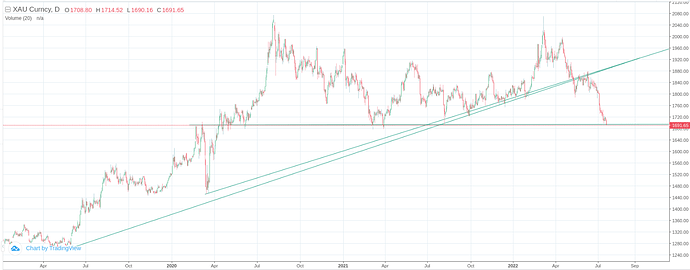Global Macro/Metals
Deteriorating global growth combined with an expected aggressive monetary tightening is strongly increasing recession risks and is now impacting commodity prices even in a tight supply environment. The Fed is expected to deliver a 1.75% hike by the end of the year (1.25% by September), the ECB a 1.5% hike while the People’s Bank of China easing policy is struggling to improve financial conditions1 in the country. For gold the question remains to know whether further tightening will be incorporated in addition to what has been priced in by the market. Central banks are looking at whether inflation will lower and the tightness of the job market, which has shown signs of release from the last numbers. Lower growth with a high level of inflation (i.e. stagflation) should lead developed countries’ investors to build a bullish momentum on the yellow metal (gold now down 2% YTD). Industrial metals are directly impacted by current (in China) and expected (in Europe and US) lower growth. Copper and aluminum were down 20 and 30% respectively over the past quarter. As the level of inventory remains low, any rebound of activity is likely to trigger further volatility and the next bull market. Platinum group metals are also affected by their industrial usage and are experiencing the same correction, particularly as they are increasingly subjected to financial liquidation.
Gold Spot Price in USD
Energy
The correction of the oil market has not changed the medium term constructive supply outlook. The anticipation of slower growth has not yet impacted global oil demand and the financial liquidation of an overcrowded long position triggered the recent correction. The supply side remains tight even as Russian exports have remained strong last month; whether Russian oil will continue to flow in the international market is questionable. The risk comes from Russia’s ability to shift its oil exports from Europe to Asia as European countries are putting in place their ban, the issues that could reduce Russian oil export to Asian countries are logistics and infrastructure limitations. Russia may also want to cut its oil exports to inflate prices and destabilize the west sanctions. In both cases, the tail risk for extreme volatility spike as we have seen earlier this year remains and given low levels of inventory with high prices, we could also see high recession risk and demand destruction, but this is less likely at this stage given the post-covid demand ramp-up.
Agriculture
As the wheat harvest is progressing, in Ukraine, it is expected to be about 25% to 40% worse than last year due to the war. The Black Sea blockade seems to have been resolved by land and sea shipping via the Danube in Romania. Wheat was down 20% in June as Russia also kept its export flowing.
Volatility
Volatility in the equity sector was a touch higher in June, with VIX up from 26.19% to 28.71% on the month, as equity markets continued their correction. Concerns about persistent inflation (now at 40-year high in the US) and signs of growth slowdown (with key economic figures such as retail sales and housing starts missing expectations) have brought the SP 500 to post its worst first half performance since 1970. More recently however, the sentiment seems to be improving, as strong job figures and the decline in commodity prices seem to bring about the possibility of a soft landing. Volatility in commodity sectors has once again not seen any change on the month, with implied volatility still gravitating around 50% for crude, 15% for gold and low 30s for corn, as markets seem to be dismissing the risk of a sudden rebound in prices.
1 Read our latest report to our proprietary index on Commodity Leading Index Economic Activity China and Commodity Leading Index Monetary China

